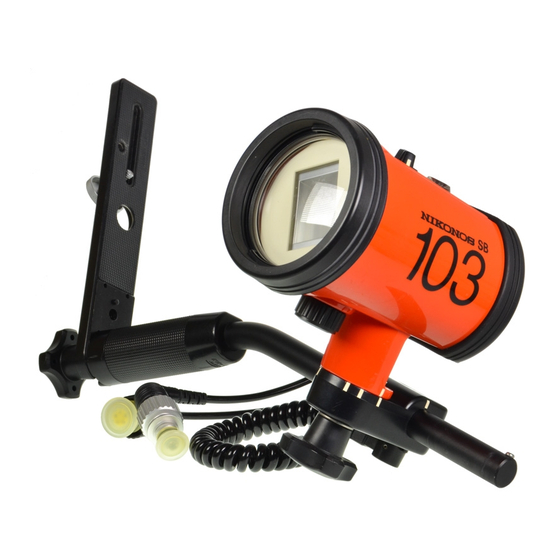Nikon Nikonos Speedlight SB-103 Instruction Manual - Page 5
Browse online or download pdf Instruction Manual for Camera Flash Nikon Nikonos Speedlight SB-103. Nikon Nikonos Speedlight SB-103 28 pages.
Also for Nikon Nikonos Speedlight SB-103: Instruction Manual (29 pages)

PREPARATION-confinued _ _ _ _ _ _ _
Examining and lubricating the O·rings:
1. To remove the O-rings, except the one in the synchro
socket cover, grasp the ring between your thumb and
forefinger. Pinch your fingers together as you slide
them in the direction of the arrow to create slack in
the O-ring. Then grasp the slack portion with your
other hand and pull the ring off (see Fig.
1).
To remove the O-ring in the synchro socket cover,
use the edge of a credit card or dive card or some
thin
,
blunt, instrument. Never use a knife or other
sharp·edged object. Push up on the center of the
cover with a fingertip (or pOinted object), insert the
card under the ring, and pull it up to lift the O-ring out
(see Fig
.
2). Do not scratch the O-ring in the process.
2.
Visually examine each O-ring for
imperfections.
If
any O-ring is damaged (by tears, cuts, or other imper-
fections), discard it immediately. If any O-ring has dirt,
sand,
hair, or foreign matter on
it,
rinse the O-ring in
fresh water to remove it.
3. When lubricating the various parts of your flash
unit,
use only the special non·water·soluble silicone
lubricant supplied with the speedlight. Never use
other lubricants (such as Vaseline) which are water-
soluble.
4.
To lubricate the
O-rings,
smear a small amount of the
special silicone lubricant on your fingertips and then
gently run each O-ring between your fingertips. Never
use a brush or similar object to apply the lubricant
;
small hairs may fall into the channel and allow water
to enter the flash unit. While lubricating each O-ring
,
examine it with your fingertips for
imperfections.
If
an O-ring is properly lubricated
it
will glisten and will
Fig
.
1
not have
"gobs"
of lubricant on it. To ensure the
longest possible flash unit life, apply lubricant when-
ever
necessary.
Lubrication protects the O-rings from
excessive wear
;
it also makes it easier to attach or
remove other
parts.
5.
Visually examine the channels into which the O-rings
fit to determine that each is clean and smooth
.
If any
channel is dirty, clean it with a non-lint-bearing mate-
rial. Coat each channel with a thin film of lubricant
while being careful not to apply too much.
6.
Reseat all of the O-rings with your fingertips by in
-
serting one side of the ring into the channel and
holding it in position while rolling the other side of the
ring into place (see Fig
.
3).
To insert the O-ring into
the channel of the synchro socket cover, push up on
the center of the cover with a fingertip (or pointed
object), place the ring over the channel, then press
it down into place. Check that the O-ring
is
not twisted
and that each of its edges is properly seated (see
Fig
.
4).
7.
Check the surfaces which are opposite the O-rings
to determine that each is clean, smooth
,
and free of
foreign matter. Clean and lubricate the
surfaces
in
the same manner as the channels
.
8.
When reattaching the parts with
O-rings,
be sure that
each O-ring seats properly and securely. All of the
O-rings must be properly aligned and not
"pinched."
